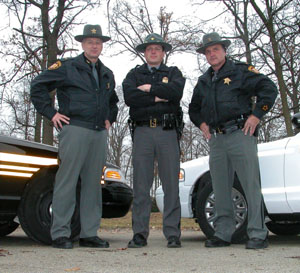By Shelley Grieshop
sgrieshop@dailystandard.com Stop. Look both ways.

It's a simple instruction and one that local law enforcement officers wish motorists would heed.
"The actions taken by drivers at stop signs are more of a problem than just about anything else we deal with," says Lt. Dan Lay, commander of the Wapakoneta post of the Ohio State Highway Patrol (OSHP).
Failure to yield the right of way at intersections topped the list again in 2005 as the most frequent cause of accidents in the Grand Lake area. In the last five years, 44 percent of crashes in Mercer County and 36 percent in Auglaize County occurred due to motorists who entered intersections without yielding the right of way.
The OSHP tallies traffic crash statistics for both counties and continually reports their findings to the state. In 2005 there were six fatal traffic accidents that killed six people in Auglaize County, including one 16-year-old driver; in Mercer County, 10 people died in nine fatal crashes and half of those killed were teenagers. The total number of people who died on area roadways fell from 21 in 2004; but sadly nearly half of those were teens.
Area law enforcement officers say they do their best to prevent accidents but realize they can't be everywhere. Limited resources such as manpower can limit their visibility in the community, and they know from experience that the presence of a cruiser makes drivers more cautious, they say.
Mercer County Sheriff Jeff Grey believes reducing his on-the-road staff the last 12-15 months for budget reasons may have been a mistake.
"We have now brought our manpower back up almost to our 2003 level. It is my hope that more visibility of cars will reduce the fatal crash rate we have recently experienced," Grey says.
Both counties have a few specific intersections where accidents occur more frequently each year, Lay says. Jefferson Township, the most populated area in Mercer County, and St. Marys and Duchouquet (Interstate 75) townships all rank at the top of that list.
Troopers give a lot more warnings than traffic citations, Lay says. Of the 18,976 traffic stops made from January to October 2005, troopers gave 12,561 verbal warnings and issued just 6,415 citations. Many of the citations were for serious driving offenses such as failure to yield and failure to maintain an assured clear distance ahead. "You're not going to get a warning for those," Lay adds.
There's been a steady increase in seat belt usage locally in the last 10 years, but it could be better, Lay says. In the last five years, about 41 percent of the people killed in Mercer County and 64 percent in Auglaize County weren't buckled up.
"It's very senseless not to wear one," Lay says. "It's such a simple task and easy to get used to even when you're riding in the back seat. If everyone in every vehicle wore a seat belt, I think we'd reduce the number of people killed dramatically."
Solomon believes the key to fewer accidents is educating rookie drivers before they get behind the wheel.
"When I teach driver's ed classes I tell kids they have to be in control of their vehicle at all times," Solomon says. "Even though it takes just a split second to adjust a radio or CD player, that's all the time it takes for something bad to happen."
Solomon says he also reminds young drivers they are responsible for every person in their vehicle. "They have to understand that the life of every passenger depends on them," he adds.
Both sheriff departments and the OSHP are involved in Responsible And Careful Everytime (RACE), an educational program they initiated about a year ago that periodically brings officers to area schools to remind students to drive safely.
Later this month all three law enforcement agencies will announce the adoption of a national program geared at keeping parents informed about the driving habits of their children under the age of 21. STOPPED, Sheriffs Telling Our Parents & Promoting Educated Drivers, identifies inexperienced drivers by a decal placed in the windshield of their vehicles. If a young driver is pulled over by an officer, the information about the traffic stop is mailed to the parents.
"We are always looking for ways to reduce crashes," Grey says. "We hope this program will be embraced by parents as we work together to keep our children safe." |

